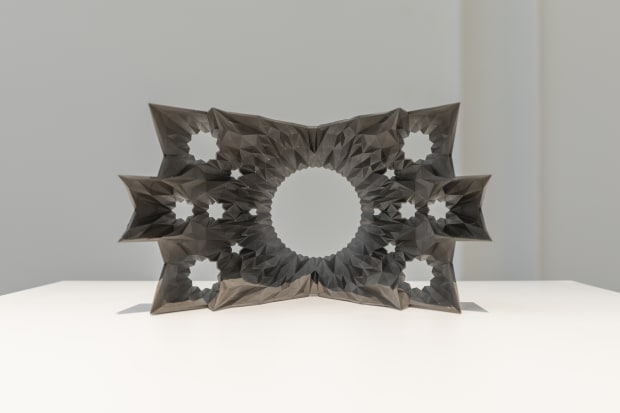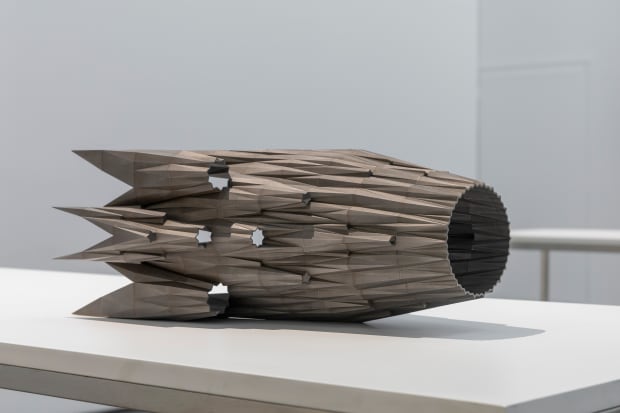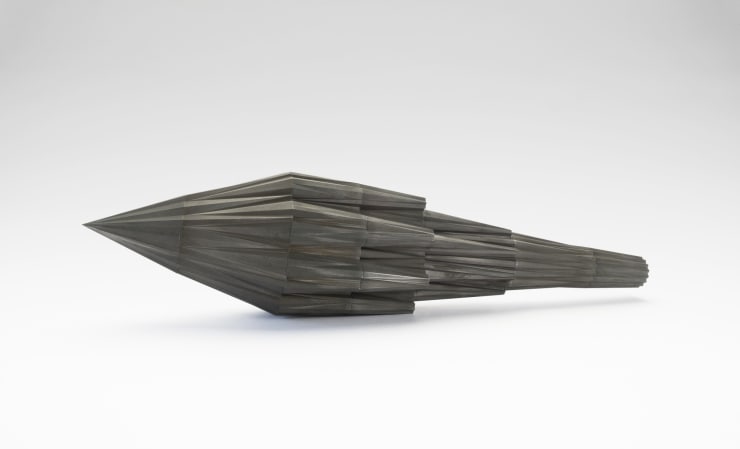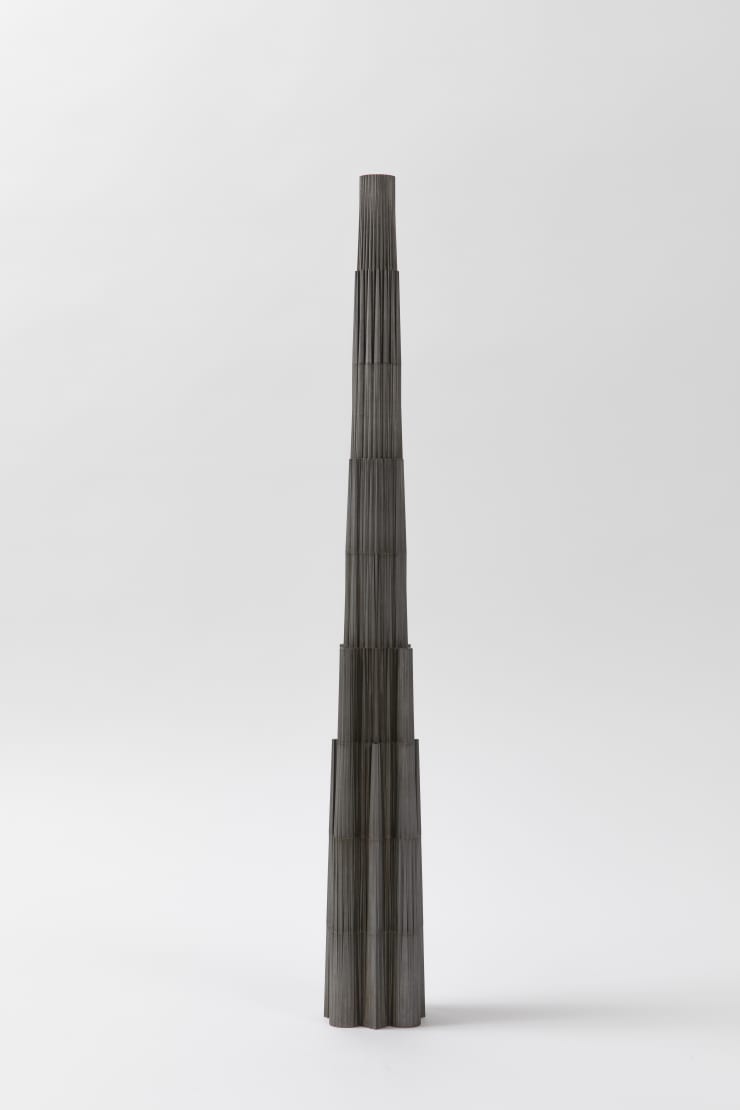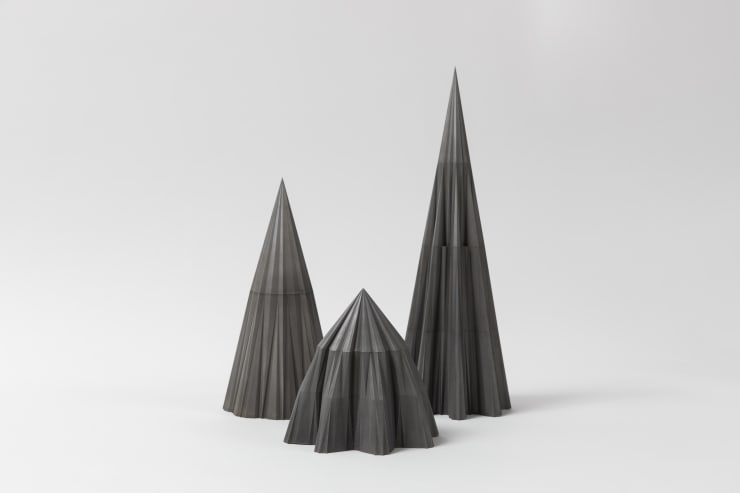-
SAHAND HESAMIYAN
PROPLESIS
-
The Third Line is pleased to announce our third solo exhibition with Sahand Hesamiyan. Marking the artist’s 24-year journey with steel, Prolepsis will showcase a collection of sculptures that celebrate his dedication to this medium, and shine a light on a trove of long-cherished yet unrealised projects.
-
Latent Potency: The Speculative Power of Sahand Hesamiyan’s Sculptures
Kevin Jones -
 Installation view, Sahand Hesamiyan, Prolepsis, 2023, The Third Line. Photo credit Ismail Noor, Seeing Things Studio
Installation view, Sahand Hesamiyan, Prolepsis, 2023, The Third Line. Photo credit Ismail Noor, Seeing Things Studio -
-
 Sahand Hesamiyan, Pillars of Victory, 2023, Steel Mo40 Steel 45 Rockwell Hardness, Two Pieces, 45 x 11 x 11 cm, 37 x 9.7 x 9.7 cm, Edition of 3, 2AP
Sahand Hesamiyan, Pillars of Victory, 2023, Steel Mo40 Steel 45 Rockwell Hardness, Two Pieces, 45 x 11 x 11 cm, 37 x 9.7 x 9.7 cm, Edition of 3, 2AP -
"While it is true that the works in Prolepsis contain the DNA of unrealized projects, they hold a power far more potent than mere intention, than some embryonic signpost of an imagined outcome."
While it is true that the works in Prolepsis contain the DNA of unrealized projects, they hold a power far more potent than mere intention, than some embryonic signpost of an imagined outcome. They are eminently self-referential[1], harking back to the very process from which they sprang. Hesamiyan shows us the murky area of creation—the zoomed-in joinery, the projected material and finishing, the intricacy of receding muqarnas. ‘Maquette’ seems insufficient as a descriptor, relying as it does on conjecture, on a ‘might happen.’ Equally, ‘prototype’ is bogged down in testing and hypotheses. Hesamiyan’s works are narratives in their own right, less beholden to the ‘final’ work, more jockeying between inception and conclusion. The rhetorical device of prolepsis, from which the show slyly takes its title, foregrounds this movement. Commonly known as a ‘flash-forward’ (the temporal counterpart of flashback), prolepsis is an anticipation: it represents an inexistent thing as existing, from within the moment of speaking. Time is collapsed, and the narration fills the void. Hesaminyan’s works in Prolepsis repeatedly leap between this moment of speech (the work made manifest), back to a shadowy genesis, and forward to an inexistent existence. This is a complex dance; one he has never shown us before.
-
-
 Sahand Hesamiyan, Kayhan, 2023, Steel Mo40 Steel 45 Rockwell Hardness, 28.4 x 40.7 x 16 cm, Edition of 3, 2AP
Sahand Hesamiyan, Kayhan, 2023, Steel Mo40 Steel 45 Rockwell Hardness, 28.4 x 40.7 x 16 cm, Edition of 3, 2AP -
[1] I remember a 2016 visit to Hesamiyan’s Tehran studio and a small sculpture lying atop a worktable I had discovered accidentally. Nail (2012) was a slice of metal folded to resemble a nail—a sharp, spike of a statement. It struck me how this work was talking about itself, its own imbrication in a process of creating sculpture that is, ultimately, itself.
-
-
Worklist
-
 Sahand HesamiyanEmtedad, 2023Steel Mo40 Steel 45 Rockwell Hardness7.6 x 56.8 x 7.6 cmEdition 1 of 3, 2AP
Sahand HesamiyanEmtedad, 2023Steel Mo40 Steel 45 Rockwell Hardness7.6 x 56.8 x 7.6 cmEdition 1 of 3, 2AP -
 Sahand HesamiyanKanoon I, 2020Steel Mo40 Steel 45 Rockwell Hardness40 x 9.5 x 10 cmAP1, Edition of 3, 2AP
Sahand HesamiyanKanoon I, 2020Steel Mo40 Steel 45 Rockwell Hardness40 x 9.5 x 10 cmAP1, Edition of 3, 2AP -
 Sahand HesamiyanKhesht I, 2023Steel Mo40 Steel 45 Rockwell Hardness9 x 9 x 5 cmEdition 1 of 10, 3AP
Sahand HesamiyanKhesht I, 2023Steel Mo40 Steel 45 Rockwell Hardness9 x 9 x 5 cmEdition 1 of 10, 3AP -
 Sahand HesamiyanKhesht II, 2023Copper9 x 9 x 5 cmEdition 1 of 10, 3AP
Sahand HesamiyanKhesht II, 2023Copper9 x 9 x 5 cmEdition 1 of 10, 3AP -
 Sahand HesamiyanKhesht III, 2023Steel Mo40 Steel 45 Rockwell Hardness9 x 9 x 5 cmEdition 1 of 10, 3AP
Sahand HesamiyanKhesht III, 2023Steel Mo40 Steel 45 Rockwell Hardness9 x 9 x 5 cmEdition 1 of 10, 3AP -
 Sahand HesamiyanMejmar I, 2023Steel Mo40 Steel 45 Rockwell Hardness11.5 x 26.4 x 11.5 cmEdition 1 of 3, 2AP
Sahand HesamiyanMejmar I, 2023Steel Mo40 Steel 45 Rockwell Hardness11.5 x 26.4 x 11.5 cmEdition 1 of 3, 2AP -
 Sahand HesamiyanMejmar II, 2023Steel Mo40 Steel 45 Rockwell Hardness11.5 x 21.2 x 11.5 cmEdition 1 of 3, 2AP
Sahand HesamiyanMejmar II, 2023Steel Mo40 Steel 45 Rockwell Hardness11.5 x 21.2 x 11.5 cmEdition 1 of 3, 2AP -
 Sahand HesamiyanMenar, 2020Steel Mo40 Steel 45 Rockwell Hardness64.7 x 7.8 x 7.8 cmEdition of 3, 2AP
Sahand HesamiyanMenar, 2020Steel Mo40 Steel 45 Rockwell Hardness64.7 x 7.8 x 7.8 cmEdition of 3, 2AP -
 Sahand HesamiyanNeshaan, 2023Steel Mo40 Steel 45 Rockwell Hardness12.5 x 12.5 x 35.5 cm. 12 x 12 x 23.9 cm.14.7 x 14.7 x 13.7 cmEdition of 3, 2AP
Sahand HesamiyanNeshaan, 2023Steel Mo40 Steel 45 Rockwell Hardness12.5 x 12.5 x 35.5 cm. 12 x 12 x 23.9 cm.14.7 x 14.7 x 13.7 cmEdition of 3, 2AP -
 Sahand HesamiyanUntitled, 2020Steel Mo40 Steel 45 Rockwell Hardness7 x 29 x 7 cmEdition 1 of 3, 2AP
Sahand HesamiyanUntitled, 2020Steel Mo40 Steel 45 Rockwell Hardness7 x 29 x 7 cmEdition 1 of 3, 2AP -
 Sahand HesamiyanKanoon II, 2020Steel Mo40 Steel 45 Rockwell Hardness24.5 x 9.5 x 10 cmAP1, Edition of 3, 2AP
Sahand HesamiyanKanoon II, 2020Steel Mo40 Steel 45 Rockwell Hardness24.5 x 9.5 x 10 cmAP1, Edition of 3, 2AP
-
-
About Sahand Hesamiyan
Born in 1977 in Tehran, Sahand Hesamiyan holds a Bachelor of Sculpture from the University of Tehran. The artist's versatile practice is informed by a profound understanding of construction techniques, culminating in larger than life metal sculptures and small elaborate works on paper. By creating interactive pieces that eclipse the mere repetition and reflection of thesetraditional forms, Hesamiyan is able to convey his acute technical abilities while taking inspiration from years of craftsmanship and historical concepts.
Embracing the close ties between geometry, mythology, and philosophy, Hesamiyan is focused on extracting traditional elements from these ancient sciences and adapting them for the present and future. His explorations often manifest in the formof complex sculptures, whether they be freestanding objects or multifaceted wall installations. As a master of designing structural systems, Hesamiyan reinterprets Yazdibandi and Rasmibandi which are historic design methods utilized in the interior ornamentation of domes in Persian architecture.
Selected solo exhibitions include: Far Side, Emrooz Gallery, Isfahan, Iran (2022); Majaz, BLOK Art Space at Cukurcuma and Buyuk Valide Han, Istanbul (2017); Frame Reference, Dastan Outside the Basement, Tehran, Iran (2015); Tavizeh, Dastan’sBasement, Tehran, Iran (2015); Khalvat, The Third Line, Dubai, UAE (2014); Sulook, The Third Line, Dubai, UAE (2013);Memory Lives On, Aun Gallery, Tehran, Iran (2011); Do You See Me!, Ave Gallery, Tehran, Iran (2008).
Sahand’s work is included in important private and public collections, including: the Delfina Entrecanales Collection, Imago Mundi – Luciano Benetton Collection, The Samawi Collection and MAC.
-
About Kevin Jones
Kevin Jones is a brand and content strategist, arts writer, and educator who is interested in the self-representational strategies of art practitioners in the MEASA region, specifically the ways in which they write about their practices.
New York-born and Paris-bred, Kevin has lived in the Middle East for the past seventeen years, serving as UAE Desk Editor for the magazine ArtAsiaPacific, while contributing criticism both internationally (The Art Newspaper, Artforum, ArtReview and FlashArt International) and regionally. As an educator, he taught as part of Art Jameel’s Hayy Learning initiative for emerging Saudi artists in Jeddah in December 2019, and has been a faculty member at Dubai-based non-profit Tashkeel from 2015 to 2021.
Kevin holds a BA with a double major English Literature/Journalism from Northwestern University. His MA is in Linguistics/Semiotics from La Sorbonne Nouvelle (Paris III).
He is currently Director of Strategy at Alserkal Initiatives.
Sahand Hesamiyan: Prolepsis
Past viewing_room

